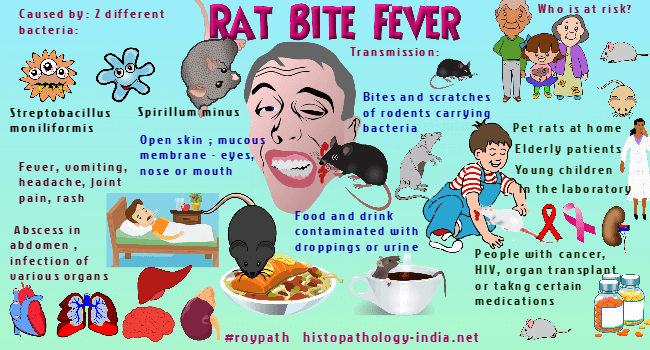|

Custom Search
|
|
Infectious Disease Online Pathology of Rat Bite Fever
|

|
Rat-bite fever (RBF} is an uncommon disease known for its endemicity
to occur worldwide.
Although most patients tend to develop mild symptoms with improvement from conventional antibiotics, it can progress with severe complications with a mortality rate as high as 13% without proper treatment. This is a systemic infection that afflicts people in areas where rat control is lacking. Rat-bite fever takes two forms : (i) Rat-bite fever by Streptobacillus moniliformis is also known as Haverhill fever. (ii) The second form of RBF, named Sodoku by the Japanese because of its high incidence in that country, is caused by the bacteria Spirillum minus (Spirillum minor). Causative organisms: There are two distinct organisms and hence two diseases. (i) One of the agent is a spirochete, Spirillum minus (Spirillum minor), 0.15 micrometer wide and 2 to 5 micrometer long, with one to six spirals. (ii) The second cause is streptobacillum moniliformis , a gram negative bacillus, 0.1 to 0.7 micrometer wide and 1 to 5 micrometer long, which appears as clusters of organisms in tissue, forming long wavy chains or filaments. Mode of infection: Human infection can result from a bite or scratch from an infected or colonized rat, handling of an infected rat, or ingestion of food or water contaminated with infected rat excreta. Clinical presentation: Rat-bite fever caused by S. moniliformis has an incubation period ranging from 1 to 22 days. Disease is characterized by flu-like symptoms including irregularly relapsing fever accompanied by chills, vomiting and headaches, and asymmetric polyarthritis generally affecting the large joints. This is followed by a maculopapular rash on the extremities, palms and soles. Most cases resolve with treatment but if left untreated result in fatality in 13% of the cases. Complications of rat bite fever include bacterial endocarditis, myocarditis, and pericarditis, and abscesses in the brain or other tissues, tenosynovitis. Other complications include regional lymphadenopthy, anemia, meningitis, pneumonia, and myalgia. [In a fatal case of Streptobacillus moniliformis in an infant the autopsy findings included an interstitial pneumonia, fibrinous endocarditis,mild mononuclear meningitis, hepatosplenomegaly and lymphadenopathy , erythrophagocytosis and sinusoidal mononuclear cell infiltrates in regional lymph nodes and the liver.] Sodoku is characterized by a recurrent fever. A roseolar-urticarial rash sometimes develops. Arthritis is usually rare. There is regional lymphadenitis and lymphangitis with accompanying flu-like symptoms including malaise , headaches, and enlargement of the lymph nodes adjacent to the wound. The diagnosis of streptobacillary rat-bite fever is made after isolation of Gram-negative bacilli from a blood-culture and from cutaneous lesions. Finally identification of the organism is confirmed by molecular biology analysis. Physicians should consider RBF as a possible diagnosis when fever, rash, and exposure to rats are part of the patient's history. Zoonotic infections may present a significant hazard to persons with occupational or recreational exposure to rats. Education on hazards of animal contact and other preventive measures are essential to prevent this disease. Penicillin is effective in Spirillum minor infection.
|
|
|
Copyright © 2022 histopathology-india.net


